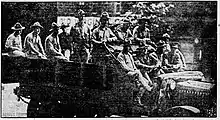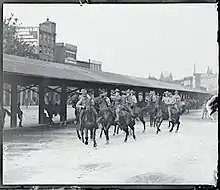Washington race riot of 1919
The Washington race riot of 1919 was civil unrest in Washington, D.C. from July 19, 1919, to July 24, 1919. Starting July 19, white men, many in the United States Army, United States Navy, and United States Marine Corps, responded to the rumored arrest of a black man for rape of a white woman with four days of mob violence against black individuals and businesses. They rioted, randomly beat black people on the street, and pulled others off streetcars for attacks. When police refused to intervene, the black population fought back. The city closed saloons and theaters to discourage assemblies. Meanwhile, the four white-owned local papers, including the Washington Post, fanned the violence with incendiary headlines and calling in at least one instance for mobilization of a "clean-up" operation.[3] After four days of police inaction, President Woodrow Wilson ordered 2,000 federal troops to regain control in the nation's capital.[4] But a violent summer rainstorm had more of a dampening effect. When the violence ended, 15 people had died: at least 10 white people, including two police officers;[5] and around 5 black people. Fifty people were seriously wounded and another 100 less severely wounded. It was one of the few times in 20th-century riots of whites against blacks that white fatalities outnumbered those of black people.[6] The unrest was also one of the Red Summer riots in America.
| Part of Red Summer | |
 Coverage of the riots in Washington, D.C. on July 23, 1919 | |
| Date | July 19–24, 1919 |
|---|---|
| Location | Washington D. C., United States |
| Deaths | 15-40 [A 1] |
| Non-fatal injuries | 150 |

Background
Washington D.C. had evolved as one of the places in the United States where a significant number of successful African-Americans were living, with a particular concentration in the Le Droit Park area, near Howard University. This area had originally been segregated as a White-only zone, but students from Howard University had torn down the gates as part of a wider initiative to desegregate the suburb in 1888. The city as a whole was 75% composed of White Americans. To this racial mix newspaper publisher Ned McLean sought to undermine city authorities by publishing real or imagined crimes and "no crime was as salacious as a black attack on a white woman."[2] The white population were outraged by reports of black crime and during the summer of 1919 large mobs roamed streets attacking black residents.
The riot
1st night, July 19

The race riot started on Saturday July 19 following an incident involving two African-American men and Elsie Stephnick, the white wife of an employee of the United States Naval Aviation Department.[7] She was "jostled" near New York Avenue, and 15th Street Northwest.[7] One of the men was arrested and questioned concerning an alleged sexual assault, but subsequently released.[3] The preceding weeks had seen a sensationalist newspaper campaign concerning the alleged sexual crimes of a "negro fiend", which contributed to the violence of the succeeding events.[3] A mob of White Americans formed and started attacks on several African Americans and also an African-American family home.
3rd day, Monday July 21
Alarmed by the press calling for armed intervention to crush the black population, the city's black community groups spent $14,000 ($206,000 in 2021) on guns and ammunition in order to defend themselves.[2] Many blacks gathered with guns they had purchased from pawn shops or military rifles black soldiers had brought home from WWI, to make a stand at around Seventh and U streets, the black district in the capital's northwest. There, sharpshooters shot at targets while perched on the roof of the Howard Theatre.[1] Many black citizens took to their cars cruising the streets and shooting up white targets. One vehicle driven by Thomas Armstead and five other passengers cruised north along 7th Street, guns blazing. Near M Street, they shot a police horse, hit the hat off a cop's head before being stopped by a group of police. Armstead and another passenger, 18-year-old Jane Gore, were shot dead, their companions escaped.[2]
4th day, July 22
A 17-year-old black girl, Carrie Johnson, shot at white mobs from her New York Avenue window. Police raided her home and she fatally shot a white policeman, Detective Harry Wilson and claimed self-defense.[8] A bullet caught her in the thigh and her father, Ben Johnson, was shot in the shoulder. She was arrested and charged with the shooting.[2] In January 1921 a trial was finally heard, U.S. v. Carrie Johnson.[9] Her father did not testify, but the prosecutor announced in front of the jury that charges against Ben Johnson had been dropped, implying that Carrie Johnson must have committed the crime. She was convicted of manslaughter, but a separate judge accepted the self-defense argument and overturned the verdict. To avoid a second trial all charges were dropped and Carrie Johnson went free on June 21, 1921.[9]
Aftermath
The NAACP sent a telegram of protest to President Woodrow Wilson:[10][11]
...the shame put upon the country by the mobs, including United States soldiers, sailors, and marines, which have assaulted innocent and unoffending negroes in the national capital. Men in uniform have attacked negroes on the streets and pulled them from streetcars to beat them. Crowds are reported ...to have directed attacks against any passing negro....The effect of such riots in the national capital upon race antagonism will be to increase bitterness and danger of outbreaks elsewhere. National Association for the Advancement of Colored People calls upon you as President and Commander in Chief of the Armed Forces of the nation to make statement condemning mob violence and to enforce such military law as situation demands...
November Park Riot
On November 1, 1919, Albert Valentine Connors, 1014 Pennsylvania avenue southeast, a park policeman, was assaulted by a crowd of African-Americans in an alley near Seventh and K streets southeast, shortly afternoon. Connors was making an arrest when he was mobbed by the large crowd. After being stabbed and beaten he was able to call for more police and the crowd dispersed.[12]
See also
| Wikimedia Commons has media related to Washington race riot of 1919. |
Further reading
- Brockell, Gillian (July 15, 2019). "The deadly race riot 'aided and abetted' by The Washington Post a century ago". Washington Post.
- McWhirter, Cameron (2011). Red Summer: The Summer of 1919 and the Awakening of Black America. Henry Holt and Company. ISBN 9781429972932.
- Spears, Charles Alan (1999). This Nation's Gratitude: The Washington, D.C. Race Riot of 1919. M.A. thesis, Howard University.
Annotations
- Official reports claim a death toll of 15 (10 whites and 5 blacks).[1] Author Michael Schaffer claims that "the violence claimed 30 to 40 lives ... those estimates make the riots almost three times as deadly as the far more famous upheavals of April 1968."[2]
Bibliography
Notes
- Lewis 2015
- Schaffer 1998
- Perl 1999, p. A1
- "Washington, D.C. Race Riot (1919) – The Black Past: Remembered and Reclaimed". www.blackpast.org.
- ODMP Memorials Wilson and Halbfinger
- Ackerman 2011
- Rucker & Upton 2007, p. 683
- Sauer 2019.
- Morley 2019.
- New York Times: "Protest Sent to Wilson," July 22, 1919. Retrieved January 21, 2010.
- GlobalSecurity.org 2019
- The Washington Herald 2019, p. 1.
References
- Ackerman, Kenneth (2011). Young J. Edgar: Hoover and the Red Scare, 1919–1920. Viral History Press LLC. ISBN 9781619450011. - Total pages: 467
- GlobalSecurity.org (2019). "Race Riots of 1919". GlobalSecurity.org. Retrieved July 5, 2019.
- Lewis, Tom (November 2, 2015). "How Woodrow Wilson Stoked the First Urban Race Riot". Politico. Retrieved July 5, 2019.
- Morley, Jefferson (July 17, 2019). "The D.C. Race War of 1919: And the forgotten story of one African American girl accused of murdering a police officer". The Washington Post. ISSN 0190-8286. OCLC 2269358. Retrieved July 22, 2020.
- Sauer, Patrick (July 17, 2019). "One Hundred Years Ago, a Four-Day Race Riot Engulfed Washington, D.C." Smithsonian Magazine. Retrieved July 23, 2020.
- Perl, Peter (March 1, 1999). "Race Riot of 1919 Gave Glimpse of Future Struggles". The Washington Post. Retrieved July 6, 2019.
- Rucker, Walter C.; Upton, James N. (2007). Encyclopedia of American Race Riots, Volume 2. Greenwood Publishing Group. ISBN 9780313333026. - Total pages: 930
- Schaffer, Michael (April 3, 1998). "Lost Riot: Thirty years ago this week, Washington burned. Seventy-nine years ago this summer, the city bled. Why we shouldn't forget the riots of 1919". Washington City Paper. Retrieved July 5, 2019.
- The Washington Herald (2019). "Policeman Beaten By Gang of Negroes". The Washington Herald. ISSN 1941-0662. OCLC 9470809. Retrieved November 2, 2019.
